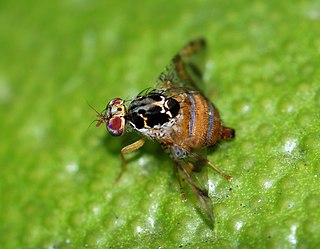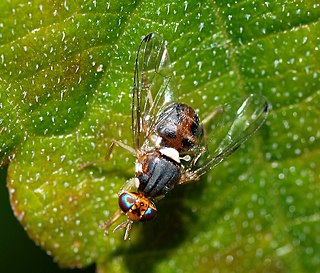
The sterile insect technique (SIT) is a method of biological insect control, whereby overwhelming numbers of sterile insects are released into the wild. The released insects are preferably male, as this is more cost-effective and the females may in some situations cause damage by laying eggs in the crop, or, in the case of mosquitoes, taking blood from humans. The sterile males compete with fertile males to mate with the females. Females that mate with a sterile male produce no offspring, thus reducing the next generation's population. Sterile insects are not self-replicating and, therefore, cannot become established in the environment. Repeated release of sterile males over low population densities can further reduce and in cases of isolation eliminate pest populations, although cost-effective control with dense target populations is subjected to population suppression prior to the release of the sterile males.

Ceratitis capitata, commonly known as the Mediterranean fruit fly or medfly, is a yellow-and-brown fly native to sub-Saharan Africa. It has no near relatives in the Western Hemisphere and is considered to be one of the most destructive fruit pests in the world. There have been occasional medfly infestations in California, Florida, and Texas that require extensive eradication efforts to prevent the fly from establishing itself in the United States.

Ceratitis is a genus of tephritid fruit flies with about 80 species. One of the best known species is Ceratitis capitata, the Mediterranean fruit fly.

The Dacinae are a subfamily of the fruit fly family Tephritidae. Its 41 genera are distributed among three tribes:
C. silvestrii may refer to:
Blennidus podocarpi is a species of ground beetle in the subfamily Pterostichinae. It was described by Moret in 1995.
Heppnerographa podocarpi is a species of moth of the family Tortricidae. It is found in Ecuador.
Ceratitis rosa, or commonly known as the natal fruit fly, is a fruit fly species from the family Tephritidae of the order Diptera. It is considered a pest in both its native and non-native habitats. It prefers subtropical or temperate climates and the fruits that are native to these areas. It is also capable of surviving in less dry climates compared to its relative, the Ceratitis capitata which is more specific in its habitats, described by Anton Ferdinand Karsch in 1887 in Delagoa Bay, Mozambique. Not long after in 1900, the natal fruit fly was a recognized pest for orchards and fruit farmers throughout KwaZulu Natal Province, Republic of South Africa.
Trichaptum podocarpi is a species of fungus in the order Hymenochaetales. It differs from species in its genus by having totally resupinate basidiocarps, distinctly long cystidia, and in its habitat on Podocarpus. It was first isolated from China.
Ceratitis ovalis is a species of tephritid or fruit flies in the family Tephritidae. It is known from Sierra Leone.
Ceratitis grahami is a species of insect in the family Tephritidae. It is known from Ghana, from the East Guinean Forest ecoregion.
Ceratitis flexuosa is a species from the kingdom Animalia, family Tephritidae. This is a genus of Tephritid or fruit flies.
Ceratitis penicillata is a species of fruit fly from the family Tephritidae.
Ceratitis aliena is a species of insect in the family Tephritidae. This is a genus of Tephritid or fruit flies.
Ceratitis andranotobaka is a species of tephritid fruit fly.
Bondarzewia podocarpi is a species of polypore fungus in the family Russulaceae. Described as new to science in 2010, it is found in Hainan, China, where it grows parasitically on Podocarpus imbricatus.

Stenoscelis is a genus of snout and bark beetles in the family Curculionidae. There are at least 30 described species in Stenoscelis.
Neophyllaphis podocarpi, the podocarpus aphid, is a species of aphid in the family Aphididae.

Ernest James Harris was an American entomologist who is best known for his work on Biosteres arisanus, a species of wasp. He was inducted into the Arkansas Black Hall of Fame in 1999.





